
What do mussels do when subjected to warmer water?
Shelby Clarke picks up a cluster of mussels from a tank. She is measuring mussel death rates, she explains. Scientists are investigating how mussels will react to future heat waves.
Norway’s Institute of Marine Research has a research station on the strait in Austevoll municipality outside Bergen.
Huge halibut, eel and lobster live in pools there. Salmon swim in new experimental cages farther out.
One of the buildings houses mussels. Here Shelby Clarke and her colleagues have set up an ingenious experiment to test the endurance limits of the shellfish.
“We know that mussels living close to their upper temperature limit may not do so well during heat waves,” says Clarke.
“We’ve already seen incidents of mass mortality, for example in Canada,” she says.
Mussels fried by the sun
CNN reported the death of millions of mussels in Canada during a heat wave in 2021.
The mussels were cooked alive when it was low tide and they were exposed to direct sun. But higher water temperatures also have the potential to affect mussels, and this is what Clarke is investigating.
Clarke is from Canada and is a visiting researcher at the Marine Research Institute in Bergen.

Measures how many mussels die
Inside it is hot and humid and the technical installations are noisy. Seawater is pumped in and distributed among the water tanks.
The mussels are in rows of small tubs that range from normal sea temperatures to future heat waves in the oceans.
They are housed in water that is 15, 20, 25 or 30 degrees Celsius, with identical conditions otherwise.
Clarke picks up a cluster of mussels. In these tanks she measures death rates, she explains.
“I look at how quickly the mussels die at different temperatures.”
She has already removed the day’s waste. The mussels that succumb are measured, frozen, and samples are taken.


More stressful the higher the temperature
Clarke is already noticing how the water temperature is impacting the mussels.
“At 20 degrees, we see almost no mortality. But at 25 and 30 degrees we see higher mortality.”
“The higher the temperature, the more stressful it is for the mussels.”
Some of the mussels are collected right outside the research station. Another group comes from a nearby coastal area where the water is naturally warmer.
“We want to find out if the mussels from the warmer water survive longer than the mussels from the colder water when they’re exposed to increasing temperatures,” Clarke says.
The idea behind the approach is that mussels from an area with higher temperatures might be genetically adapted and better able to handle the heat, she says.
The experiment is still underway, but so far this assumption seems to be correct.
“The preliminary results I’ve seen show that the difference in survival rate does appear related to the mussels’ place of origin.”
Sensor provides information
Clarke has another trick for studying how the shellfish react. She holds out a mussel that has a small magnet and sensor installed on the shell.
The sensor detects when the mussel closes or opens its shell.
“This measuring technique can provide a lot of data about mussel behaviour. This is relevant because when the mussel shell is closed, it can’t eat or breathe. This can affect growth,” says Clarke.
When mussels are closed for a long time, it means they are not happy. Everything in the experiment but the temperature is the same and ideal for the shellfish. So when they stay closed for longer periods, it is due to the heat.
A screen shows a bar graph that tells Clarke how many mussels are open or closed.
Clarke reaches down into the tank and touches the mussels, and they shut again to protect themselves. This is registered on the screen in real time.

Population changes
Øivind Strand is a researcher at the Institute of Marine Research and leads the institute's focus on low-trophic aquaculture, which are species that are low in the food chain.
The venture includes Clarke’s project. Strand is otherwise not involved in the study.
He believes that the project contributes useful knowledge. Strand says that there are examples of changes in the occurrence of mussels where temperature and climate change might be a factor.
“Perhaps the clearest example is that Svalbard has mussels again. We know that there have been mussels in Svalbard in the past. Now they’ve returned,” he says.
“On the east coast of the USA, the mussel populations have moved north. We’re seeing a lot of signs that something is happening. So the research that Shelby is doing, to see how mussels from different places respond to higher temperatures, is important.”
Monitoring in Norway
Norway’s Institute of Marine Research has started a monitoring programme for natural mussel deposits.
“The background is that over several years we received reports that people found that the mussels were gone, especially in Southern Norway and in the Oslo Fjord. The question is whether the natural populations are undergoing a change.
A number of factors might be at play (in Norwegian).
“For instance, people in the Oslo Fjord are not finding mussels where they previously harvested them to eat,” says Strand.
“That could well be the case. Probably the mussels aren’t able to grow to maturity, because they get eaten. We see that people’s engagement is very good, but the mussels are simply being eaten.”

Breathing less
To really gain an overview of how the mussels react to temperature, Clarke has also set up experiments that show how much the mussels are breathing and eating.
Along one wall are mussels with small pockets of water full of oxygen. Clarke can turn off the flow so that the mussels stay in the same water over time.
Then she can measure how the level of oxygen changes and in this way see how much the mussels are breathing.
She tests how the mussels from both sources react to different temperatures.
“At low temperatures, they don't breathe as much. As you increase the temperature, breathing increases until an optimal temperature is reached.”
When the temperature gets higher than that, the mussels breathe less again. The graph will probably look like an arc.
“We have to wait and see if that’s what the data actually shows, but in theory it’s what we think they will show.”



Heat waves have an impact
In the final experiment, Clarke measures how much the mussels eat. An automatic system takes samples of the water and sends it to a machine that counts the particles in the water.
“We feed them algae, three types of phytoplankton.”
Water from containers without mussels is compared with water from the tubs where mussels are held. Clarke looks at how temperature affects appetite.
So far, the preliminary data suggest that the mussels from the cold source feed more at low temperatures, while those collected in a warmer water source feed more at higher temperatures.
Clarke summarizes what the research suggests so far: “Heat waves have the potential to affect mussels in the future.”
The increased temperature during heat waves can negatively affect breathing, eating and survival, she says, and this can have ecological and economic effects.
“The severity of a heat wave also has implications for mussel functioning, where activity decreases with increasing temperature. They function worse at 30 degrees than 25 degrees,” Clarke says.

Breeding and management
Clarke says that the knowledge from the experiments will be useful in several fields.
The data can be used by researchers who want to model what kind of effects climate change will have along the coast.
They can be useful in resource management and in mussel farming.
“Under future climate scenarios, the mussels’ response, growth and production could be different if they’re forced to live in temperatures that aren’t ideal for them,” Clarke says.
Another objective of the experiment is to find out if some mussels are more tolerant of higher temperatures than others. Mussels that are resistant could be used in breeding stocks in the aquaculture industry when sea temperatures rise.
———
Read the Norwegian version of this article at forskning.no
































